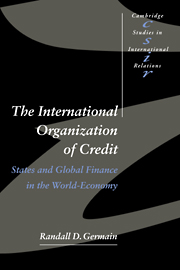Book contents
- Frontmatter
- Contents
- List of figures and tables
- Preface
- Note on figures and tables
- Glossary
- 1 Routes to international political economy: accounting for international monetary order
- Part 1 The international organization of credit in historical perspective
- Part 2 The contemporary international organization of credit
- 4 The era of decentralized globalization
- 5 Decentralized globalization and the exercise of public authority
- 6 Finance, power, and the world-economy approach: towards an historical–institutional international political economy
- Appendix: Top merchant/investment banks, by city and era
- References
- Index
- CAMBRIDGE STUDIES IN INTERNATIONAL RELATIONS
4 - The era of decentralized globalization
Published online by Cambridge University Press: 14 January 2010
- Frontmatter
- Contents
- List of figures and tables
- Preface
- Note on figures and tables
- Glossary
- 1 Routes to international political economy: accounting for international monetary order
- Part 1 The international organization of credit in historical perspective
- Part 2 The contemporary international organization of credit
- 4 The era of decentralized globalization
- 5 Decentralized globalization and the exercise of public authority
- 6 Finance, power, and the world-economy approach: towards an historical–institutional international political economy
- Appendix: Top merchant/investment banks, by city and era
- References
- Index
- CAMBRIDGE STUDIES IN INTERNATIONAL RELATIONS
Summary
Although the events of 1971 shook the postwar foundations of international monetary order, they did not collapse in the same way that the cessation of international clearance through London in 1931 prompted the complete breakdown of monetary order in the interwar period. Certain elements of the postwar monetary order did of course change, such as the determination of exchange rates, the value of the US dollar, the role of gold as a reserve asset, and the expectation that deficit economies would, in the normal course of events, adjust their international accounts. But the overall international organization of credit, as chapter 3 argued, remained remarkably stable in the face of changing political and economic circumstances. As the 1970s wore on, however, a number of important changes gathered pace which did occasion a major structural transformation of monetary order in the mid-1980s. These changes are most clearly represented by the emergence of Tokyo as a PFC that began to rival New York and London, and by the globalization of the world's major monetary agents. Twenty-five years from the formal end of Bretton Woods we are at the point where a relatively small number of highly capitalized firms operating out of a select number of PFCs wield an enormous amount of influence over the access which firms and governments have to international credit. The phrase which best evokes this two-fold movement, and which serves to define the contemporary period, is decentralized globalization.
To identify the international organization of credit as being marked by decentralized globalization is to recognize that its central institutional nexus of credit networks has no definitive hub.
- Type
- Chapter
- Information
- The International Organization of CreditStates and Global Finance in the World-Economy, pp. 103 - 136Publisher: Cambridge University PressPrint publication year: 1997

